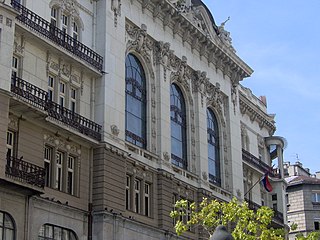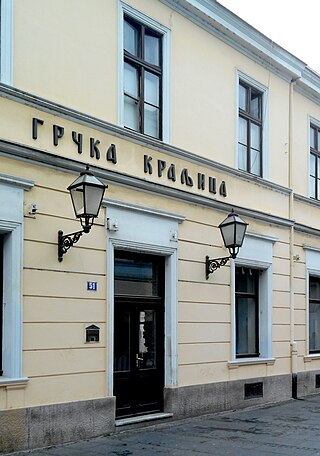
Košutnjak is a park-forest and urban neighborhood of Belgrade, the capital of Serbia. It is divided between in the municipalities of Čukarica and Rakovica. With the adjoining Topčider, it is colloquially styled "Belgrade's oxygen factory". The 1923 Belgrade's general plan, in which one of the main projects regarding the green areas was forestation of the area between Topčider and the city, envisioned a continuous green area Senjak – Topčidersko Brdo – Hajd Park – Topčider – Košutnjak, which was formed by the 1930s. This continual forested area makes the largest "green massif" in the immediate vicinity of Belgrade's urban tissue.

Sava Centar is an international congress, cultural and business center of various multi-functional activities located in Belgrade, the capital of Serbia. It is the largest audience hall in the country and the entire former Yugoslavia, as well as one of the biggest in Europe. It has hosted numerous large-scale events and performances.

Palace Albanija is a high-rise building in Belgrade, Serbia. Important construction and architectural innovations were incorporated into the project, which made Albanija an exceptional building endeavor in the Balkans. When completed in 1939, it was the first skyscraper in Southeast Europe. It remained the tallest building in Belgrade for 3 years, until being surpassed by BIGZ building in 1941. It remained the tallest building in the old part of Belgrade for the next 34 years, until being surpassed by the Beograđanka in 1974.

Skadarlija is a vintage street, an urban neighborhood and former municipality of Belgrade, Serbia, located in the Belgrade municipality of Stari Grad. Skadarlija partially preserves the ambience of traditional urban architecture, including archaic urban organization, and is known as the main bohemian quarter of Belgrade, similar to Montmartre in Paris. Since 1967, Skadarlija has been protected by law as a spatial cultural-historical unit.

Knez Mihailova Street is the main pedestrian and shopping zone in Belgrade, and is protected by law as one of the oldest and most valuable landmarks of the city. Named after Mihailo Obrenović III, Prince of Serbia, it features a number of buildings and mansions built during the late 1870s.

The Serbian Academy of Sciences and Arts is a national academy and the most prominent academic institution in Serbia, founded in 1841 as Society of Serbian Letters.

Terazije is the central town square and the surrounding neighborhood of Belgrade, Serbia. It is located in the municipality of Stari Grad.

Banovo Brdo is a neighbourhood of Belgrade, Serbia. It is located in Belgrade's municipality of Čukarica.

Savamala is an urban neighborhood of Belgrade, the capital of Serbia. It is located in Belgrade's municipalities of Savski Venac and Stari Grad.

Zeleni Venac or colloquially Zelenjak is an urban neighborhood of Belgrade, the capital of Serbia. It is located in the Belgrade's municipalities of Savski Venac and Stari Grad.

Kosančićev Venac is an urban neighborhood of Belgrade, the capital of Serbia. It is located in Belgrade's municipality of Stari Grad. It has been described as the most valuable and most representative veduta of Belgrade. In 1971, it was declared a spatial cultural-historical unit and placed under legal protection.

London is an urban neighborhood of Belgrade, the capital of Serbia. It is located in Belgrade's municipality of Stari Grad, in the city's downtown.

The Nikola Pašić Square is one of the central town squares and an urban neighborhoods of Belgrade, the capital of Serbia. The square is named after Nikola Pašić who served as mayor of Belgrade, prime minister of Serbia and prime minister of Yugoslavia. Until 1992 the square was named the Marx and Engels Square.

Studentski Trg, or Students Square, is one of the central town squares and an urban neighborhood of Belgrade, the capital of Serbia. It is located in Belgrade's municipality of Stari Grad. In the Classical Antiquity, area of the modern square was the center of Singidunum, Roman precursor of modern Belgrade.
Šumice is an urban neighborhood of Belgrade, the capital of Serbia. It is located in Belgrade's municipality of Voždovac. It is also the name of a park-forest within the neighbourhood.

Belgrade Youth Center is a cultural center in Belgrade, the capital of Serbia, dedicated primarily to youth.

The building of the Pension Fund of the clerks and servants of the National Bank of Yugoslavia, today the building of the popular „Theatre-on-Terazije“, was built in 1939, after the design of the Russian architect Grigorije Samojlov. With one residential and several official entrances, the building opens out to two Belgrade squares – 29 Terazije Square and 3 Nikole Pašića Square.

Grčka Kraljica or Greek Queen is a former kafana in Belgrade, the capital of Serbia. Built in 1835, the building is located on Knez Mihailova Street, the commercial hub of downtown Belgrade. For decades, it was one of the favorite kafanas in the city, but it was closed in 2007.

Pioneers Park is a park in Belgrade, the capital of Serbia. Developed from the royal garden, which itself was a successor of a much older garden, it is today one of the central city parks. It has been open for public since 1944. The park has been declared a botanical natural monument.

Bezistan is a roofed square and indoor passage in downtown Belgrade, Serbia that was designed by Vladeta Maksimović in 1953. It connects Terazije and Nikola Pašić squares with the surrounding shopping area. Bezistan is on the site of former Hotel Pariz.























